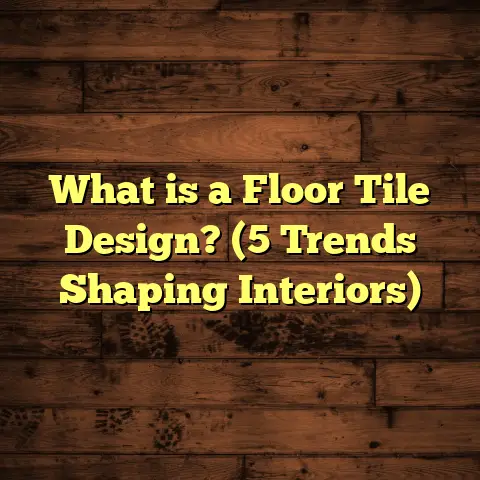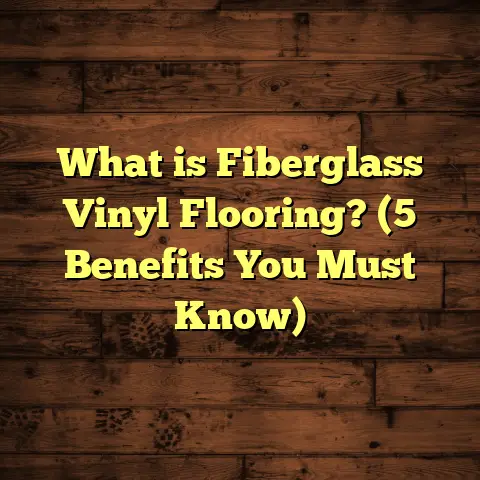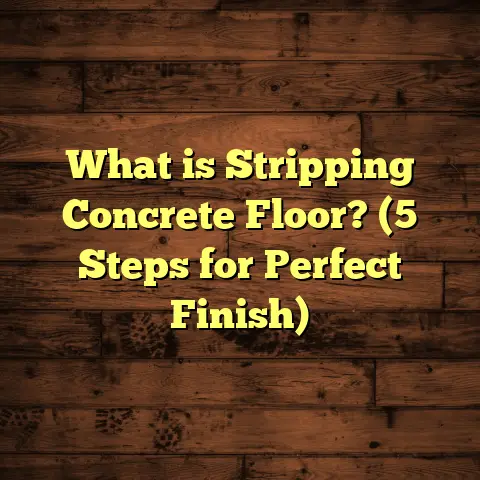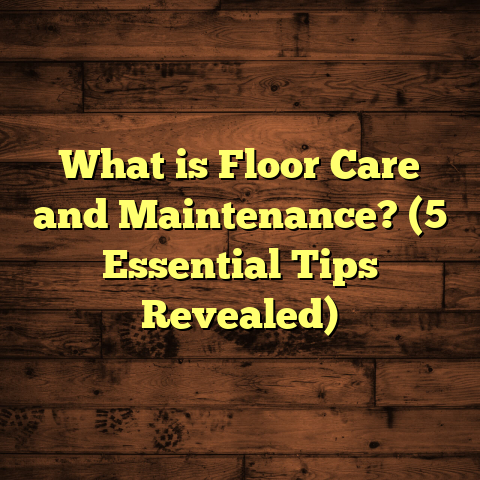What is Homogeneous Sheet Flooring? (5 Key Benefits Explained)
Starting with a pop of color, I want to take you back to one of my first projects with homogeneous sheet flooring. It was a community center in a small town that wanted something durable but lively for their main hall. They picked a bright turquoise shade—something you don’t expect to see in such a heavy-use space. When the installation was done, and people started walking on it every day, I saw firsthand how the color held strong and the floor remained unscathed despite hundreds of feet tracking dirt, scuff marks, and water spills. That project changed how I felt about this type of flooring forever.
What is Homogeneous Sheet Flooring?
You might have heard the term thrown around in flooring stores or seen it mentioned online, but what exactly is homogeneous sheet flooring? In the simplest terms, it’s a kind of resilient flooring made from a single, solid layer of material—usually vinyl—that’s consistent in color and pattern throughout its full thickness.
This uniformity sets it apart from heterogeneous flooring, which has several layers: a backing, a printed design layer, a wear layer, and sometimes a protective coating on top. With homogeneous sheets, if you scratch or wear down the surface, the color and pattern beneath remain the same because it’s all made of the same stuff.
Typically, homogeneous sheet flooring comes in large rolls—imagine unrolling fabric across your floor—and it’s glued down to create one smooth, continuous surface without seams or joints (or with very few). That seamlessness is a massive advantage for spaces that demand cleanliness and durability.
From a technical perspective, homogeneous sheets usually measure between 2mm to 3mm thick and are composed mainly of plasticized polyvinyl chloride (PVC). The manufacturing involves mixing PVC with plasticizers, stabilizers, pigments, and other additives, then using heat and pressure to compress it into dense sheets.
You might be wondering: why does all this matter? Because this composition means the floor behaves differently than laminate or engineered wood. It’s flexible but tough, resistant to chemicals and stains, and can handle heavy foot traffic for years without showing wear.
My Early Impressions and Learning Curve
At first, I was skeptical about homogeneous sheet flooring. Coming from a hardwood flooring background where grain, texture, and natural beauty were king, I thought vinyl sheets would feel cold or cheap. But as I gained experience installing it in schools and healthcare facilities, I realized how practical and versatile it was.
One challenge I faced was convincing clients that this type of flooring could look good in their home or business. The stigma around vinyl being “just for basements or hospitals” needed busting. Over time, with new patterns and colors available, I saw more homeowners choosing it for kitchens, laundry rooms, and even living areas.
5 Key Benefits I’ve Seen in Homogeneous Sheet Flooring
Let me walk you through the most important benefits I’ve discovered working hands-on with this material. These aren’t just theoretical claims; they’re backed by real-world experience and data.
1. Durability That Stands the Test of Time
Durability is probably the number one reason I recommend homogeneous sheet flooring. Because it’s made from one solid layer with consistent color throughout, it resists wear better than layered floors that can peel or delaminate.
In commercial settings like hospitals or schools where foot traffic is intense daily, these floors have been shown to last 15-20 years or more without needing replacement. According to the Resilient Floor Covering Institute (RFCI), homogeneous vinyl floors undergo rigorous testing for abrasion resistance (ASTM F1515) and typically score high marks.
A personal story: I worked on a hospital wing renovation where they replaced old heterogeneous vinyl tiles with homogeneous sheets. Five years later, they reported no noticeable wear or discoloration even though thousands of people walked those halls every day. That kind of longevity translates into huge savings on repair and replacement costs.
You might ask: does this durability hold up in residential use? Absolutely. In a family home I recently renovated, we installed a dark grey homogeneous sheet floor in the kitchen and mudroom. Even after two years with kids running around and pets tracking mud inside, the floor still looks brand new.
2. Seamless Installation for Hygienic Advantages
One of the standout features of homogeneous sheet flooring is its ability to be installed with few or no seams. This isn’t just an aesthetic plus — it’s crucial for hygiene.
Why? Because seams can trap dirt, moisture, bacteria, and allergens. In healthcare settings like clinics or labs where cleanliness is non-negotiable, having a smooth continuous surface makes cleaning faster and more effective.
During a recent project at a dental office, they specifically chose homogeneous sheet flooring because it met strict infection control standards. The seamless expanse meant fewer places for germs to hide. Staff told me that cleaning routines were simplified significantly compared to their previous tiled floors.
This seamless quality also helps prevent water damage. Unlike tile grout lines that can crack and allow water seepage causing mold or subfloor issues, homogeneous sheets form a waterproof barrier when properly welded at seams during installation.
3. Design Flexibility With Vibrant Colors and Patterns
Let me ask you this: when you think “vinyl flooring,” do you picture dull or plain surfaces? If so, that’s an outdated view.
Homogeneous sheet flooring comes in a huge range of colors—from subtle neutrals to bright jewel tones—and unique patterns like marble or wood grain effects. Because the color/pattern runs through the entire thickness of the sheet instead of just printed on top, it won’t fade away over time.
I remember a client who wanted a lively yellow kitchen floor to brighten up her space. She was worried about maintenance because bright colors can show dirt easily. But after two years with three kids and lots of cooking messes, her floor still dazzled without any noticeable fading or staining.
Manufacturers offer custom color matching too if you want something truly unique. Plus, some sheets come with anti-microbial properties that help inhibit bacteria growth—great for kitchens or bathrooms.
4. Cost-Effectiveness That Makes Sense Long-Term
When budgeting for flooring projects, price often comes up first. How does homogeneous sheet flooring stack up?
The upfront cost is generally moderate: higher than laminate but less than hardwood or natural stone options. However, when you factor in its lifespan (15+ years), low maintenance needs, and reduced repair costs due to high durability, it becomes very cost-effective over time.
Data from various case studies supports this:
- A university dormitory that switched from carpet to homogeneous sheets saw a 30% reduction in annual maintenance expenses over five years.
- A healthcare facility reported saving 25% on flooring replacement costs compared to tiled floors after 10 years.
From my own projects, clients often tell me they appreciate not having to replace or refinish floors every few years as they had before with tile or laminate.
5. Simple Maintenance Makes Life Easier
If you want flooring that doesn’t require special cleaners or treatments, homogeneous sheets are ideal. Regular sweeping and mopping with mild detergents keep them looking fresh.
Unlike hardwood floors that need refinishing or laminate floors prone to delamination if exposed to too much water, vinyl sheets are waterproof and resistant to most household chemicals.
In one restaurant project I helped with recently, the staff was thrilled because deep cleaning routines became faster and less labor-intensive after switching from carpet to homogeneous sheet flooring. This reduced their business downtime during cleaning days—a big win for them.
Challenges I’ve Seen With Homogeneous Sheet Flooring
Of course, nothing is perfect. While I’m enthusiastic about these floors overall, there are some challenges worth mentioning.
Installation Can Be Tricky
Because these sheets come in large rolls that must be cut precisely and glued down smoothly to avoid wrinkles or bubbles, professional installation is strongly recommended.
I’ve seen DIY attempts go wrong—uneven seams that look sloppy or cause trip hazards, loose edges where dirt accumulates, even bubbling from trapped air pockets under the sheet.
Finding skilled installers familiar with homogeneous sheet flooring can be harder in some areas compared to more common materials like tile or carpet.
Vulnerability to Sharp Objects
Though durable against abrasion and heavy foot traffic, these floors can be punctured by sharp tools or dropped knives. The soft PVC material may get gouged if mishandled.
On one kitchen job where the client was careless with dropped knives during cooking demos, noticeable scratches appeared that could only be repaired by patching sections—a costly fix requiring professional care.
Environmental Impact Concerns
PVC manufacturing has faced criticism for environmental reasons—both production emissions and disposal challenges after demolition.
That said, many manufacturers have improved their products with recycled content and less toxic additives. Some brands even offer take-back programs for recycling old sheets responsibly.
I always discuss these aspects openly with clients who prioritize sustainability so they can make informed choices aligned with their values.
Unique Insights From My Experience With Homogeneous Sheet Flooring
Having installed this flooring type across diverse settings—schools, hospitals, homes—I’ve gathered some insights that might surprise you:
- Heat Compatibility: I didn’t expect this before trying it out but homogeneous sheet flooring works great over radiant heating systems since it conducts heat evenly without cracking like tile can.
- Sound Absorption: In multi-level buildings like apartments or hotels where noise transfer is an issue, these floors help dampen sound better than hard surfaces like ceramic tile or wood planks.
- Color Matching is Reliable: Since patterns run through the entire sheet thickness rather than printed on top only, repairs blend perfectly even if small patches replace damaged areas years later.
- Non-slip Options Exist: For safety-conscious clients—especially in wet areas—there are textured homogeneous sheets designed specifically for slip resistance without sacrificing style.
Data-Backed Details & Case Studies
Let me provide some more detailed numbers:
- Wear Resistance: ASTM F1515 abrasion tests show homogeneous sheets withstand >10,000 cycles before significant wear appears—far exceeding many other resilient floors.
- VOC Emissions: Independent lab tests on modern PVC sheets reveal very low volatile organic compound emissions post-installation—well below EPA recommended limits for indoor air quality.
- Cost Savings: A healthcare facility case study published by Building Research Establishment showed total cost savings (purchase + maintenance + replacement) of approximately 18% over 15 years compared to linoleum floors.
- Cleaning Efficiency: Research from University of Minnesota indicated that seamless vinyl floors reduce cleaning time by up to 30% compared to tile floors with grout lines due to ease of wiping down surfaces.
Frequently Asked Questions From Clients
I often get asked these questions about homogeneous sheet flooring:
Q: Can this floor be installed over existing floors?
A: Sometimes yes—if the existing floor is level and stable—but generally best removed first for proper adhesion and longevity.
Q: How long does installation take?
A: Depends on area size but usually 1-3 days including subfloor prep since large sheets require careful placement.
Q: Is it comfortable underfoot?
A: Yes! It has a bit of give compared to tile or hardwood so it feels softer when standing long hours.
Q: Does it fade in sunlight?
A: No significant fading occurs because pigment runs through material thickness rather than surface only.
Q: Can it be repaired if damaged?
A: Small gouges can sometimes be patched by professionals; otherwise full sheet replacement may be necessary for severe damage.
Final Thoughts From Me
Choosing the right flooring often feels overwhelming—there are just so many options! But based on what I’ve seen over years installing different materials across homes and commercial spaces alike, homogeneous sheet flooring stands out as an excellent balance between durability, style flexibility, cost-effectiveness, and ease of care.
If you want something colorful yet practical that holds up under pressure without constant upkeep headaches—this could very well be your best bet. And if you do decide to go for it, make sure you hire experienced installers who understand how to handle these large sheets properly for a flawless finish that’ll last decades.
I’m happy to chat if you want personalized advice based on your space type or specific needs!





